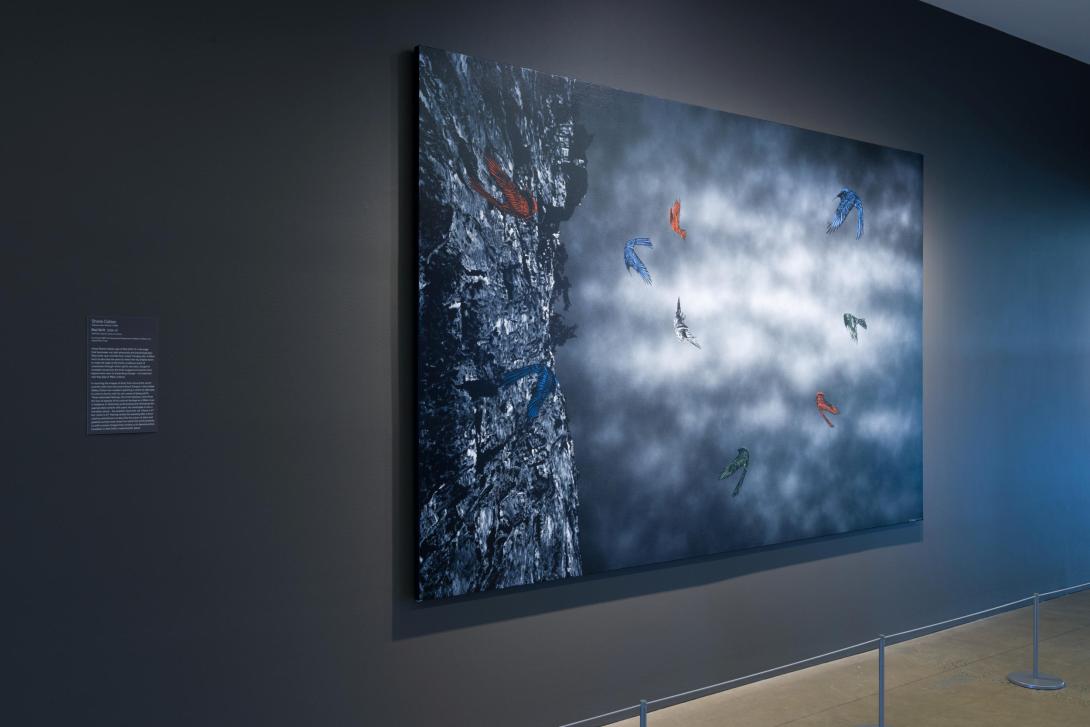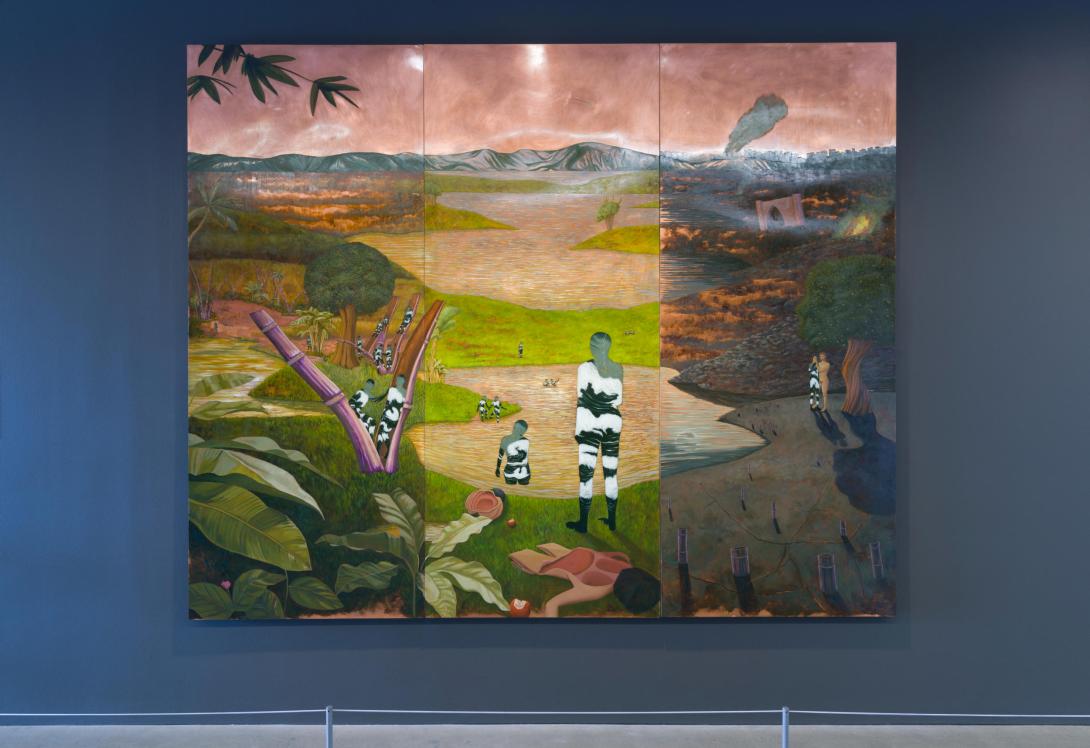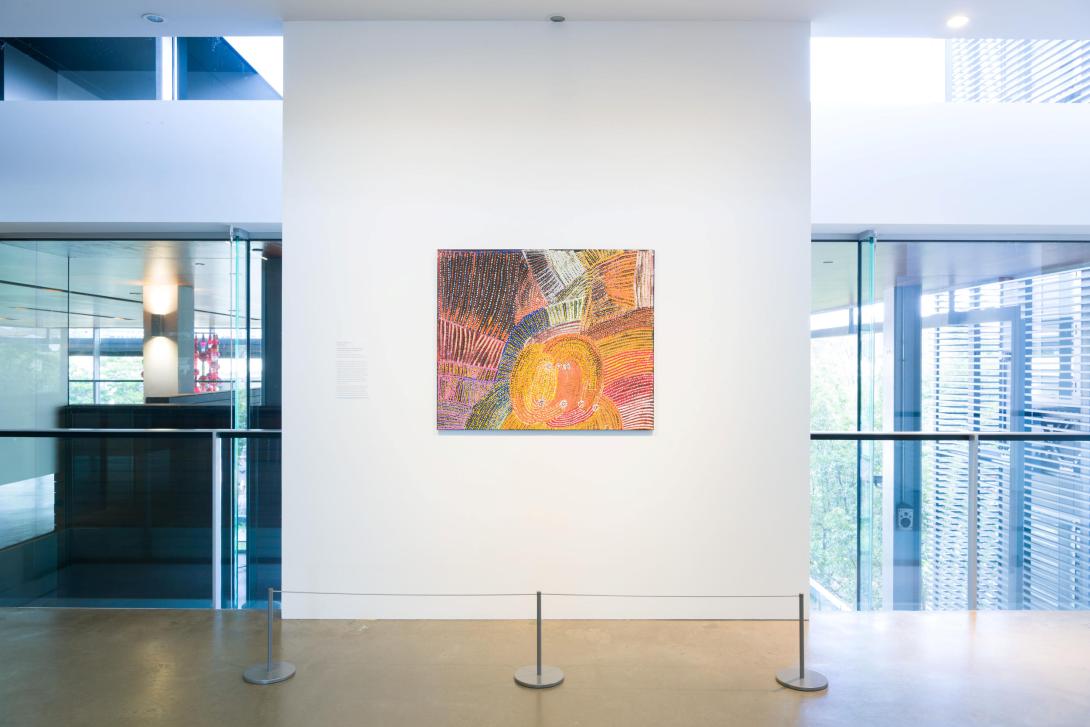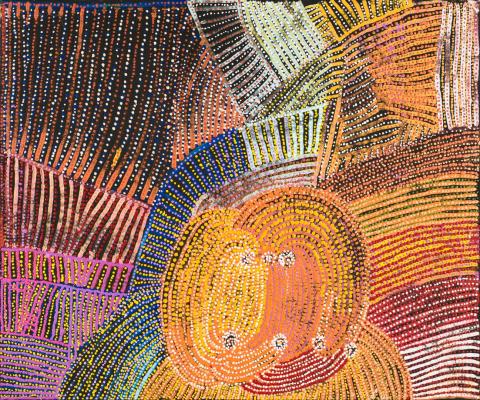COLLECTION FOCUS: ‘Journey’
By Jacinta Giles
July 2023
Artists use the idea of journeys in many ways, both literal and metaphorical, to reflect on cultural identity, personal history and transformation. In these works, drawn from QAGOMA’s Collection, the artists map their place in the world through a shared engagement with symbols, nature, motion and fluidity. The works of art in ‘Journey’ abstract conventional notions of place and time to offer alternative ways to chart one’s experience — blurring the boundaries of the real and the imaginary.

Shane Cotton’s Red Shift 2006–07, installed for ‘Journey’, GOMA, September 2023 / © Shane Cotton / Photograph: C Callistemon, QAGOMA
Artist Shane Cotton says of Red Shift, ‘It is the edge that fascinates me, both physically and psychologically’. Nine birds soar and fall from a dark ‘hanging sky’, a Māori term to describe the point at which the sky drapes down to meet the edge of the Earth, creating a point of connection through which spirits can pass. Caught in arrested movement, the birds suggest emissaries from beyond who warn of impending change — an important role they play in Māori culture.
In sourcing the images of birds from around the world and the cliffs from the iconic Grand Canyon in the United States, Cotton has created a painting in which he attempts to come to terms with his own sense of being adrift. These dislocated feelings, the artist believes, come from the loss of aspects of his cultural heritage as a Māori man in Aotearoa. In distorting, accentuating and overlaying this appropriated content with paint, the landscape is now a nameless place — the question becomes not ‘where is it?’ but ‘when is it?’ Having named the painting after a term used by astronomers to describe the colour of stars and galaxies as they move away from earth, the artist presents us with a sense of deep time, inviting us to become active travellers in Red Shift’s metamorphic space.
Chong Kim Chiew / Malaysia b.1975 / Boundary fluidity 2014 / Single-channel video: 13:46 minutes, colour, sound / Gift of the artist through the Queensland Art Gallery | Gallery of Modern Art Foundation 2021 / © Chong Kim Chiew
Maps present a universal visual language to control, codify and comprehend our world — its places, networks and boundaries. Maps also offer a means of understanding the intangible, as they are shaped by political, cultural and social conditions, as well as the personal experience and imaginative projections of their makers. Since 2008, Kim Chiew Chong has been working on his ‘Boundary Fluidity’ series, using video, photography and maps painted on large tarpaulins. These works present territory as an aesthetic and political fiction, suggesting that the control of geographies and populations is transient. In this work, Chong’s map-paintings journey through what the artist calls ‘third spaces’ — everyday public sites that are familiar yet anonymous. As the tarpaulins voyage through abandoned buildings, oceans, forests and even a street, they act as a performative intervention that provokes consideration of the power of topography, the flow of history and overlapping of cultural identities.

Lee Paje’s The stories that weren’t told 2019, installed for ‘Journey’, GOMA, September 2023 / © Lee Paje / Photograph: C Callistemon, QAGOMA
This triptych’s imaginary landscape melds elements from Filipino and Judeo-Christian traditions into a hybrid creation story that envisages a new form of paradise. In borrowing iconography and symbols from both the Judeo-Christian belief that Eve was created from Adam’s rib and the Filipino belief that both man and woman were born at the same time from a piece of bamboo, Lee Paje reflects on how stories can, in her own words, ‘shape our beliefs about ourselves and others’.
In The stories that weren’t told, Paje invites viewers to travel through an alternative vision of humanity’s origins. Within this scene, tropical plants grow around a central pool of water, where primordial beings emerge as human outlines filled with mysterious seascapes, becoming portals into the unknown. These fluid and ungendered beings cast off and step out of their skin, as if it were clothing. In transforming these origin stories and disrupting traditionally gendered narratives, Paje’s landscape provides an opportunity to wander through these historical and cultural mythologies in new ways.

Tommy Mitchell’s Walu Rockhole Dreaming, Emu Heart, The Boy Who Turned Into Wind 2012, installed for ‘Journey’, GOMA, September 2023 / © Tommy Mitchell/Copyright Agency / Photograph: C Callistemon, QAGOMA
Walu Rockhole Dreaming, Emu Heart, The Boy Who Turned Into Wind is one of Tommy Mitchell’s final major paintings. Here, Mitchell relates the story of a young boy who turned into a whirlwind at Walu Rockhole. This important living water site in the harsh Gibson Desert sits north-west of the tri-state border between Western Australia, the Northern Territory and South Australia. In the story, two men and one little boy were camping at the rockhole. The men went hunting and the boy stayed. The men returned with an emu and pulled out its heart. The boy held the heart, and the emu’s blood spilt onto the rocks; the stains can still be seen there today. The little boy ran away with the heart and turned into wind.
This work has a strong sense of motion, with the dual vortex on one side capturing the movement of the swirling winds — a feature often seen in desert willy-willy. The painting’s meandering and criss-crossing lines represent journey or song lines through desert country, which is indicated by the more uniform lines representing sandhill ridges at the base.
‘Journey’ is on display at GOMA’s Level 2 Walkway and Landing from 12 August 2023 to 7 April 2024.
Digital story context and navigation
Explore the story

‘Journey’
Aug 2023 - Apr 2024
About this page



